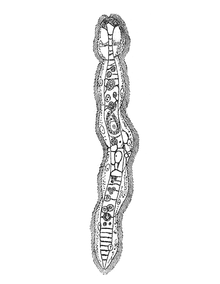Mesozoa
| Mesozoa | |
|---|---|
 | |
| Dicyema macrocephalum | |
| Scientific classification | |
| Kingdom: | Animalia |
| Subkingdom: | Eumetazoa? |
| (unranked) | Bilateria? |
| (unranked): | Mesozoa |
| Phyla | |
The Mesozoa (singular: mesozoon) are enigmatic, minuscule, worm-like parasites of marine invertebrates. As of 2012 it was still unclear whether they are degenerate platyhelminthes (flatworms) or truly-primitive, basal metazoans. Generally, these tiny, elusive creatures consist of a somatoderm (outer layer) of ciliated cells surrounding one or more reproductive cells. Decades ago, Mesozoa were classified as a phylum. Molecular phylogeny studies, however, have shown that the mysterious mesozoans are polyphyletic. That is, they consist of at least two unrelated groups.[1]
As a result of these recent findings in molecular biology, the label mesozoan is now often applied informally, rather than as a formal taxon. Some workers previously classified Mesozoa as the sole phylum of the lonely subkingdom Agnotozoa. Cavalier-Smith argued that at least some of the mesozoans are in fact protistans, not animals.[2]
In the 19th century, the Mesozoa were a wastebasket taxon for multicellular organisms which lacked the invaginating gastrula which was thought to define the Metazoa.[3]
Evolution
Mesozoa were once thought to be evolutionary intermediate forms between Protozoans and Metazoans, but now they are thought to be degenerate or simplified metazoa. Their ciliated larva are similar to the miracidium of trematodes, and their internal multiplication is similar to what happens in the sprocysts of trematodes. Mesozoan DNA has a low GC-content (40%). This amount is similar to ciliates, but ciliates tend to be binucleate. Others relate mesozoa to a group including annelids, planarians, and nemerteans.
Groupings
The two main mesozoan groups are the Dicyemida and the Orthonectida. Other groups sometimes included in the Mesozoa are the Placozoa and the Monoblastozoa.
Monoblastozoans consist of a single description written in the 19th century of a species that has not been seen since. As such, many workers doubt that they are a real group.[4] As described, the animal had only a single layer of tissue. [5]
Rhombozoan mesozoans
Rhombozoa, or dicyemid mesozoans, are found in the nephrid tracts of squid and octopuses.[6] They range from a few millimeters long with twenty to thirty cells that include anterior attachment cells and a long central reproductive cell called an axial cell. This axial cell may develop asexually into vermiform juveniles or it may produce eggs and sperm that self-fertilize to produce a ciliated infusiform larva.
There are three genera: Dicyema, Pseudicyema and Dicyemennea.
Molecular evidence suggests that this phylum are derived from the Lophotrochozoa.[7][8]
Orthonectid mesozoans
Orthonectida are found in the body spaces of various marine invertebrates including tissue spaces, gonads, genitorespiratory bursae. This pathogen causes host castration of different species.[9] Their actual phylogenetic position is uncertain, suggestions include as sister group to bilateral animals; as a relative of platyhelminthes and roundworms; as parasitic cnidarians similar to myxozoans and Polypodium hydriforme; and even as members of kingdom Protista, outside the animal kingdom.[2]
The best known of Orthonectida is the parasite of brittle stars. The multinucleate syncytial stage lives within tissues and spaces of the gonad but can spread into arms. It causes the destruction of starfish ovary and eggs to cause castration (the male gonads are usually unaffected). The stages of the plasmodium develop into more plasmodia by simple fragmentation; at some point, they decide to go sexual. The syncytia are dioecious (either male or female), but young syncytia can fuse to produce both male and female. The males are ciliated and smaller than the females. The females and the males leave the starfish and mate in the sea. Tailed sperm enters the female and fertilizes the numerous oocytes. Each oocyst produces a small ciliated larva which makes its way to another star.
The genome of one of these species - Intoshia linei- has been sequenced.[10] These animals are simplified spiralians.
References
- ↑ Pawlowski, J.; J. I. MontoyaBurgos; J. F. Fahrni; J. Wuest & L. Zaninetti (1996). "Origin of the Mesozoa inferred from 18S rRNA gene sequences". Molecular Biology and Evolution. 13 (8): 1128–32. doi:10.1093/oxfordjournals.molbev.a025675. PMID 8865666.
- 1 2 Hanelt, B.; Van Schyndel, D.; Adema, C.M.; Lewis, L.A.; Loker, E.S. (November 1996). "The Phylogenetic Position of Rhopaluva ophiocomae (Orthonectida) Based on 18s Ribosomal DNA Sequence Analysis" (PDF). Molecular Biology and Evolution. 13 (9): 1187–1191. doi:10.1093/oxfordjournals.molbev.a025683. PMID 8896370. Retrieved 14 March 2013.
- ↑ T. Syed & B. Schierwater (2002). "Trichoplax adhaerens: discovered as a missing link, forgotten as a hydrozoan, re-discovered as a key to metazoan evolution" (PDF). Vie et Milieu. 52 (4): 177–187.
- ↑ Salinella: Monoblastozoa
- ↑ Meeûs, Thierry de & Renaud, François (2002). "Parasite within the new phylogeny of eukaryotes" (PDF). TRENDS in Parasitology. 18 (6): 247–51. doi:10.1016/S1471-4922(02)02269-9.
- ↑ Hochberg, F.G. (1983). "The parasites of cephalopods: A review". Memoirs National Museum Victoria. 44: 109–145.
- ↑ Kobayashi M, Furuya H, Wada H (2009) Molecular markers comparing the extremely simple body plan of dicyemids to that of lophotrochozoans: insight from the expression patterns of Hox, Otx, and brachyury. Evol Dev 11(5):582-589
- ↑ Suzuki TG, Ogino K, Tsuneki K, Furuya H (2010) Phylogenetic analysis of dicyemid mesozoans (phylum Dicyemida) from innexin amino acid sequences: dicyemids are not related to Platyhelminthes. J Parasitol 96(3):614-625
- ↑ Robert D. Barnes (1982). Invertebrate Zoology. Philadelphia, PA: Holt-Saunders International. pp. 247–248. ISBN 0-03-056747-5.
- ↑ Mikhailov KV, Slyusarev GS, Nikitin MA, Logacheva MD, Penin AA, Aleoshin VV, Panchin YV (2016) The genome of Intoshia linei affirms Orthonectids as highly simplified spiralians. pii: S0960-9822(16)30458-4. doi: 10.1016/j.cub.2016.05.007